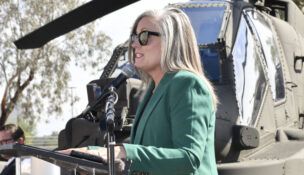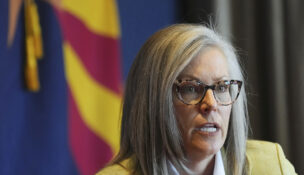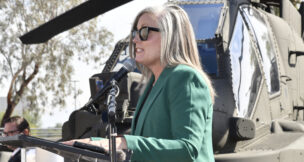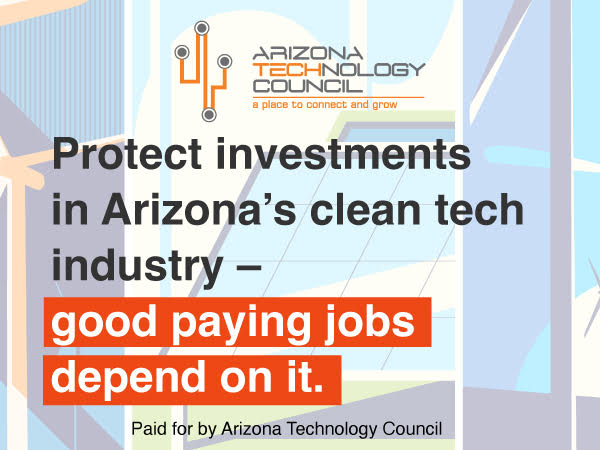Arizona governor says state lacks resources to replace food stamp cuts
Howard Fischer, Capitol Media Services//October 24, 2025//
Arizona governor says state lacks resources to replace food stamp cuts
Howard Fischer, Capitol Media Services//October 24, 2025//
Key Points:
-
Gov. Katie Hobbs says state cannot backfill food stamp benefits amid government shutdown
-
Nearly 900,000 Arizonans rely on food stamps, including over 367,000 children
-
Arizona food banks face increased pressure due to potential food stamp cuts
Gov. Katie Hobbs says the nearly 900,000 Arizonans receiving food stamps should not look to her or the state for help if benefits dry up next week due to a government shutdown. Instead, she is looking to others outside of state government.
“We’re going to really count on our nonprofit social service community to step up and be partners,” she said. But any way you look at it, the governor said, “it’s going to be very challenging for Arizonans.”
The latest figures show more than 450,000 households in Arizona rely on what is formally known as the Supplemental Nutrition Assistance Program. That includes nearly 900,000 individuals and more than 367,000 children.
“Arizona doesn’t have the capacity to backfill that,” the governor said after a ribbon-cutting ceremony at the Polytechnic Campus of Arizona State University.
Overall, the report shows that the average monthly household benefit was about $358. And the total paid during that period to all Arizonan beneficiaries was more than $161.1 million.
The governor does have some funds over which she has control.
Earlier this month, for example, she gave out $13.5 million for eviction prevention programs and to respond to those who are homeless. But Hobbs said those are dollars that are in the state budget with restrictions on how they can be used.
She also has access to federal dollars the state received as part of COVID relief, such as the $5 million the governor allocated to expand a program that provides down payment assistance for first-time home buyers.
“The COVID money is very much exhausted,” Hobbs said.
Governors elsewhere, however, say they are looking at ways to mitigate the harm to their residents.
Virginia Gov. Glenn Youngkin earlier this week declared a state of emergency over the looming loss of SNAP benefits to residents of his state. He said it would allow him to “expend emergency funds for the health, welfare, and safety of Virginians.”
In Colorado, Gov. Jared Polis asked lawmakers for $10 million to sustain food stamp assistance.
State officials in New Hampshire said they are working with food banks to set up 20 new mobile food pantries.
Louisiana Gov. Jeff Landry declared a state of emergency, saying he is “making it a top priority to ensure that seniors, individuals with disabilities, and children who rely on food stamps do not go hungry in Louisiana.” But he provided no specifics on what that entails.
And in California, Gov. Gavin Newsom said he will deploy the National Guard to help support food banks.
Hobbs brushed aside the question of why she can’t intervene similarly, given what other governors are doing.
“I’m not sure what resources they’re coming up with,” she said. “We don’t have those resources.”
Who may have the resources — at least in the short-term — is the U.S. Department of Agriculture, the agency that administers the federal SNAP program.
A group of Democratic lawmakers in Washington is urging the agency to use its $5 billion contingency reserve.
“Choosing not to ensure SNAP benefits reach those in need this November would be a gross dereliction of your responsibilities to the American people,” they wrote.
Arizona Attorney General Kris Mayes, in an Oct. 24 letter to Agriculture Secretary Brooke Rollins, said Congress appropriated at least $6 billion in contingency reserve funds, money she said “can be used to fund SNAP benefits during the shutdown.”
And the Center for American Progress, which tends to look at economic and social issues from a liberal viewpoint, contends that USDA has a “lapse of funding plan” and is “legally obligated to release these funds.”
There was no response to that query from the agency. But there’s some politics in all that.
“We are approaching an inflection point for Senate Democrats,” an agency spokesman told Capitol Media Services on Friday. “Continue to hold out for the Far Left wing of the party or reopen the government so mothers, babies and the most vulnerable among us can receive timely WIC and SNAP allotments.”
WIC stands for Women, Infants, and Children, a separate program that provides food for pregnant women and new mothers. Its funding also is at risk.
Central to all this is who is at fault for the Senate’s failure to approve a “continuing resolution” to keep federal dollars flowing.
Democrat senators — whose votes are needed — want the plan to reinstate the subsidies now being offered to people who get their health insurance through the Affordable Care Act. Republicans have responded that they’re willing to talk — only after a vote on the continuing resolution.
Others also are playing the blame game.
In his announcement declaring an emergency in Virginia, Youngkin, a Republican, said he refuses to “let hungry Virginians be used as leverage by congressional Democrats.”
And Louisiana’s Republican governor, aside from blaming Democrats for the shutdown, also encouraged residents to seek job opportunities “and free themselves from these social programs that the Left uses as a weaponization tool to win political points.”
Hobbs, a Democrat, had her own take on where the blame lies.
“It is infuriating that the president is playing politics with this,” she said. And the governor said that Trump should “follow my lead” as someone who deals with divided government.
In her case, Hobbs said she vetoed a partisan budget that cut services. But rather than getting to a point where government was shut down, “we forced the legislative leaders back to the table and we got a good budget for Arizonans.”
“And the president should be meeting instead of playing political games,” Hobbs added.
But the governor bristled at a question of whether Senate Democrats are to blame, as they could solve the problem by simply agreeing to the continuing resolution, at least for some period of time.
“Look: I don’t think it’s helpful to point fingers,” she said, even as she repeated it’s the job of the president to “bring people to the table and make them negotiate.”
“But this chaos in Washington, regardless of who’s to blame, is harming Arizonans,” Hobbs said. She said it goes beyond food stamps to include delays at airports and Arizona companies affected by disasters that don’t get their Small Business Administration loans.
All of this is going to place new pressure on food banks.
Jerry Brown, spokesman for St. Mary’s Food Bank, said his organization is already stretched.
“We’ve seen 10% increases four years in a row,” he said. And there were 2.4 million visits to the organization’s locations last year, resulting in distribution of 129 million pounds of food.
“That’s before any of this other stuff,” Brown said. And just on Friday — before any cuts in food stamps — “the line today is out the door and snaking down Thomas Road.”
Still, Brown said no one will walk away empty handed.
“We never said ‘no’ to anybody, and we’re not going to,” he said of the organization’s 58 years. But what it also means, Brown said, is that a food box that used to have 13 or 14 items in it might now have just 11 or 12.
“Hopefully, this ends in a timely fashion,” he said, and especially before the normal crush around Thanksgiving.
One other option is for those who still have October benefits on their debit cards to stock up — particularly on shelf-stable foods that can last through November. That’s exactly what is being urged by the Arkansas Department of Human Services.














































